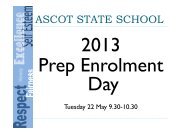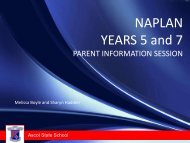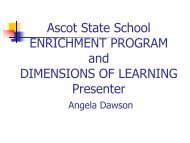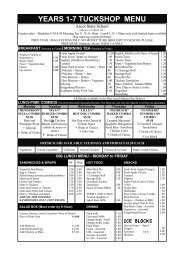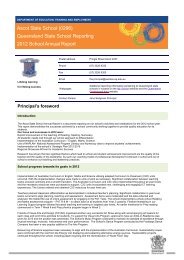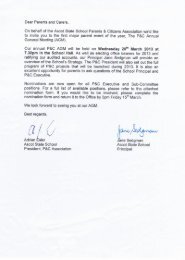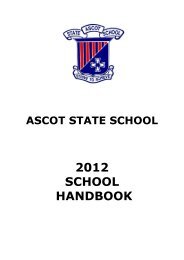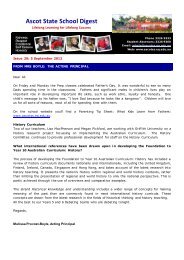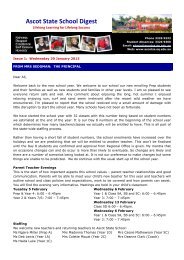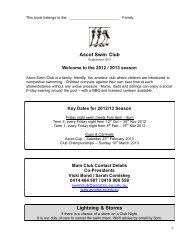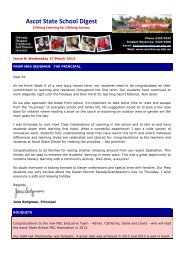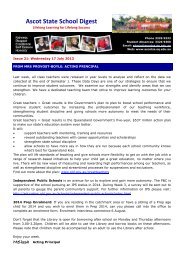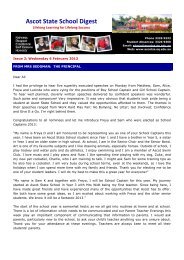Responsible Behaviour Plan - Ascot State School - Education ...
Responsible Behaviour Plan - Ascot State School - Education ...
Responsible Behaviour Plan - Ascot State School - Education ...
Create successful ePaper yourself
Turn your PDF publications into a flip-book with our unique Google optimized e-Paper software.
<strong>Ascot</strong> <strong>State</strong> <strong>School</strong><br />
<strong>Responsible</strong> <strong>Behaviour</strong> <strong>Plan</strong> for Students<br />
based on TheCode of <strong>School</strong> <strong>Behaviour</strong><br />
1. Purpose<br />
<strong>Ascot</strong> <strong>State</strong> <strong>School</strong>is committed to providing a safe, respectful and disciplined<br />
learning environment for students and staff, where students have opportunities to<br />
engage in quality learning experiences and acquire values supportive of their<br />
lifelong wellbeing.<br />
This <strong>Responsible</strong> <strong>Behaviour</strong> <strong>Plan</strong> for Students is designed to facilitate high<br />
standards of behaviour so that the learning and teaching in our school can be<br />
effective and students can participate positively within our school community.<br />
2. Consultation and data review<br />
<strong>Ascot</strong> <strong>State</strong> <strong>School</strong>developed this plan in collaboration with our school<br />
community. Broad consultation with parents and staffwas undertaken through<br />
Student Support Committee and <strong>School</strong> Advisory Council which includes<br />
representation by staff and parents.<br />
A review of the following important data sets for this school relating to<br />
attendance, unexplained absences, suspensions and exclusions, behaviour<br />
incidents including bullying and cyberbullying has been conducted prior to the<br />
development of this plan.Data pertaining to other inappropriate online behaviour<br />
including inappropriate use of mobile phones or other electronic devices from<br />
2009-2012 also informed the development process.<br />
The <strong>Plan</strong> was endorsed by the Principal, the President of the P&C and Assistant<br />
Regional Director in November 2012, and will be reviewed in 2015 as required in<br />
legislation.<br />
3. Learning and <strong>Behaviour</strong> statement<br />
All areas of <strong>Ascot</strong> <strong>State</strong> <strong>School</strong>are learning and teaching environments.We<br />
consider the <strong>Responsible</strong> <strong>Behaviour</strong> <strong>Plan</strong> to be an opportunity for valuable social<br />
learning as well as a means of maximising the success of student learning<br />
programs.<br />
Our <strong>Responsible</strong> <strong>Behaviour</strong> <strong>Plan</strong> outlines our system for facilitating positive<br />
behaviours and responding to inappropriate and unacceptablebehaviours.<br />
Through our school plan,shared expectations for student behaviour are<br />
transparent and shared,assisting<strong>Ascot</strong> <strong>State</strong> <strong>School</strong>to create and maintain a<br />
positive and productive learning and teaching environment. All school community<br />
membershave clear and consistent expectations and understandings of their role<br />
in the educational process.<br />
Our school community has identified the following beliefs to teach and promote<br />
our high standards of responsible behaviour:<br />
• The development of respect for the safety and well-being of all its<br />
members;<br />
• Respecting the right of everyone to learn/teach to their potential;<br />
• The development of responsible and peaceful behaviour through problem<br />
resolution in a fair and equitable way;<br />
• Respecting the values of our school, state and nation;<br />
• The adherence of routines essential to the operation of the school; and<br />
• Caring for the school environment and for one another.<br />
1
These beliefs operate effectively in a supportive school environment where:<br />
• All members feel safe and are valued;<br />
• Quality curriculum programs, interpersonal relationships and the organisation of the school<br />
produce worthwhile social and academic outcomes for all;<br />
• Non-discriminatory, non-violent and equitable actions are practised and reinforced;<br />
• <strong>School</strong> policy reflects both proactive steps to encourage self-worth and self-discipline, and<br />
reactive procedures to deal with various situations that may arise; and<br />
• Through a graduation of procedures, all avenues of management are employed prior to the<br />
use of suspension and exclusion.<br />
Our school values have been agreed upon and endorsed by all staff and our school community.<br />
They are aligned with the values, principles and expected standards outlined in <strong>Education</strong><br />
Queensland’s Code of <strong>School</strong> <strong>Behaviour</strong>.<br />
4. Processes for facilitating standards of positive behaviourand responding to unacceptable<br />
behaviour<br />
Universal <strong>Behaviour</strong> Support<br />
The first step in facilitating standards of positive behaviour is communicating those standards to<br />
allstudents. At<strong>Ascot</strong> <strong>State</strong> <strong>School</strong>we emphasise the importance of directly teaching students the<br />
behaviours expected at school. Communicating behavioural expectations is a form of universal<br />
behaviour support - a strategy directed towards all students designed to prevent inappropriate<br />
behaviour and provide a framework for responding to unacceptable behaviour.<br />
Some students at <strong>Ascot</strong> <strong>State</strong> <strong>School</strong> require high levels of support to ensure the development of<br />
appropriate behaviours. Consequently behavioural goals are regularly part of the Individual<br />
<strong>Education</strong> <strong>Plan</strong> for the students and strategies are developed and implemented to facilitate<br />
behavioural skill development. A student profile is developed to fully inform staff about the<br />
appropriate methods of working with the student.<br />
A set of behavioural expectations in specific settings has been attached to support our school<br />
beliefs. The <strong>School</strong>wide Expectations Teaching Matrix below outlines our agreed rules and specific<br />
behavioural expectations in all school settings.<br />
2
SCHOOLWIDE EXPECTATIONS TEACHING MATRIX<br />
ALL AREAS CLASSROOM PLAYGROUND STAIRWELL TOILETS<br />
PICK UP<br />
ZONES/BIKE RACKS<br />
BE RESPECTFUL<br />
• Use equipment<br />
appropriately<br />
• Keep hands, feet<br />
and objects to<br />
yourself<br />
• Walk<br />
• Sit still<br />
• Practise effective<br />
listening skills<br />
• Enter and exit room<br />
in an orderly manner<br />
• Respect the opinion<br />
of others<br />
• Participate in school<br />
approved games<br />
• Walk whilst moving<br />
through the school<br />
grounds<br />
• Wear appropriate<br />
footwear at all times<br />
• Be sun safe; wear a<br />
broad brimmed hat<br />
• Rails are for hands<br />
• Walk one step at a<br />
time<br />
• Carry items<br />
• Keep passageways<br />
clear at all times<br />
• Respect privacy of<br />
others<br />
• Respect school<br />
property<br />
• Use own<br />
bike/scooter only<br />
• Walk bike/scooter to<br />
the gate<br />
• Walk bike/scooter<br />
through school<br />
grounds<br />
• Follow the directions<br />
of the pick-up zone<br />
supervisor<br />
BE RESPONSIBLE<br />
• Ask permission to<br />
leave the classroom<br />
• Be on time<br />
• Be in the right place<br />
at the right time<br />
• Follow instructions<br />
straight away<br />
• Be prepared<br />
• Complete set tasks<br />
• Take an active role<br />
in classroom<br />
activities<br />
• Keep work space<br />
tidy<br />
• Be honest<br />
• Be a problem solver<br />
• Return equipment to<br />
appropriate place at<br />
the sports bell<br />
• Report incidents to<br />
the supervising<br />
teacher<br />
• Move peacefully in<br />
single file<br />
• Use toilets during<br />
breaks<br />
• Move promptly from<br />
your classroom to<br />
the pick-up zone<br />
• Remain in the pickupzone<br />
until it is time<br />
to leave<br />
BE SAFE<br />
• Respect others’<br />
personal space and<br />
property<br />
• Care for equipment<br />
• Clean up after<br />
yourself<br />
• Use polite language<br />
• Wait your turn<br />
• Raise your hand to<br />
speak<br />
• Respect others’ right<br />
to learn<br />
• Talk in turns<br />
• Be a good listener<br />
• Play fairly – take<br />
turns, invite others to<br />
join in and follow<br />
rules<br />
• Care for the<br />
environment<br />
• Walk quietly and<br />
orderly so that<br />
others are not<br />
disturbed<br />
• Wash hands<br />
• Walk<br />
• Wait your turn<br />
• Keep your<br />
belongings nearby<br />
• Wait in line until you<br />
have been directed<br />
by a line supervisor<br />
to move to the car<br />
These expectations are communicated to students via a number of strategies, including:<br />
• <strong>Behaviour</strong> lessons conducted by classroom teachers;and<br />
• Reinforcement of learning from behaviour lessons on <strong>School</strong> Assemblies and during active supervision by staff during classroom and nonclassroom<br />
activities.<br />
3
Our whole school approach supports the provision of a safe and supportive learning environment<br />
through:<br />
• Open communication with the school community on key strategies, including The Code of<br />
<strong>School</strong> <strong>Behaviour</strong> and the school’s <strong>Responsible</strong> <strong>Behaviour</strong> <strong>Plan</strong> for Students;<br />
• Shared school values and a positive and inclusive culture that recognises the contributions<br />
of all members of the school community;<br />
• Establishment of agreed programs and procedures that address harassment, bullying,<br />
violence and child protection that are known and understood by all members of the school<br />
community;<br />
• Staff, student and parent access to professional development or training on appropriate<br />
prevention and response strategies for addressing harassment, bullying, violence and child<br />
protection;<br />
• Management of incidents via clear and well-understood processes, community engagement<br />
and strong relationships with relevant support specialists;<br />
• Provision of support for students and staff; and<br />
• Working closely with parents/caregivers.<br />
<strong>Ascot</strong> <strong>State</strong> <strong>School</strong>implements the following proactive and preventative processes and strategies<br />
to support student behaviour.<br />
Positive Reinforcement<br />
Positive reinforcement is a well-documented means of promoting and maintaining acceptable and<br />
appropriate behaviours. At <strong>Ascot</strong> <strong>State</strong> <strong>School</strong>, energy is directed by classroom teachers,<br />
administration and support staff into reinforcing positive behaviour through actions such as:<br />
• Verbal praise<br />
• Written praise – notes, letters to parents/caregivers<br />
• Awards - stickers, certificates<br />
• Recognition at assemblies<br />
• Other awards decided by the class teacher<br />
Social Skilling<br />
At <strong>Ascot</strong> <strong>State</strong> <strong>School</strong>, a detailed and developmentally appropriate social skill program is<br />
implemented in P-3 “High Five”. In the Middle Phase, we use “ICE” and “Bullying No Way”. There<br />
is a strong focus on developing positive relationships and interactions, improving verbal and nonverbal<br />
communication.Positive behaviours are taught and are reinforced both in the classroom and<br />
playground. Teachers’ skills are developed and resources are provided.<br />
Classroom Management <strong>Plan</strong><br />
Teachers:<br />
• Devise a plan in consultation with the class and then display<br />
o It is important for students to understand classroom expectations and<br />
consequences and to link these to whole-school strategies and principles<br />
o Students are involved in the development of a classroom plan as they are more<br />
likely to respect such a plan.<br />
o Classroom rules are based on the Code of <strong>School</strong> <strong>Behaviour</strong> and acknowledge that<br />
effective rules are concise, positive, clearly understood by all, reasonable,<br />
enforceable and have specific consequences<br />
o Revisit the plan on a regular basis throughout the year<br />
• Engage in quality teaching and learning<br />
o Ensure learning experiences are relevant and meaningful<br />
o Ensure that there is an appropriate level of challenge for each student<br />
o Match learning experiences and assessment techniques with student interests and<br />
learning styles<br />
o Encourage co-operative learning<br />
4
o Provide opportunities for students to make decisions about their own learning<br />
o Clearly communicate fair and reasonable expectations<br />
o Encourage students to set goals and persist in problem solving situations<br />
o Dimensions of Learning Framework is used for planning<br />
• Develop supportive interpersonal relationships<br />
o Praise the positive behaviours displayed by children<br />
o Promote, reinforce and encourage acceptable behaviour by providing a positive role<br />
model<br />
o Communicate a genuine interest in and care for the students<br />
o Establish rapport with and welcome the involvement of parents/caregivers<br />
o Develop a sense of responsibility for students’ own progress and personal<br />
behaviour goals<br />
• Establish ways to develop self esteem<br />
o Enhance and maintain self-esteem and self-discipline<br />
o Minimise criticism and accept mistakes as part of the learning process<br />
o <strong>Plan</strong> for success by breaking tasks into manageable steps which ensure individual<br />
success<br />
o Acknowledge success – use praise, notes, awards and certificates to make students<br />
feel special and communicate success to parents/caregivers<br />
o Communicate regularly with all students<br />
o Create a sense of belonging to the classroom group and within the school<br />
o Give students responsibility<br />
Strategies for Teachers<br />
• Communicate openly and honestly with students and parents/caregivers<br />
• Ensure effective communication using verbal and non-verbal cues at all stages including<br />
prevention, intervention and follow-up<br />
• Remain calm and in control<br />
• Establish and publish classroom/playground rules with clear expectations and<br />
consequences, visit regularly and review<br />
• Ensure children understand and are familiar with all aspects of the Code of <strong>School</strong><br />
<strong>Behaviour</strong> and the <strong>Responsible</strong> <strong>Behaviour</strong> <strong>Plan</strong> for Students<br />
• Know your students, their patterns of behaviour, needs and triggers for misbehaviour<br />
• Reinforce, reward and praise appropriate behaviours<br />
• Address children’s concerns immediately, or at an appropriate time and place, recording<br />
when necessary<br />
• Avoid confrontation at all costs<br />
• Share responsibility with all staff for all students<br />
• Use fair and consistent strategies that are in line with the school’s beliefs and values<br />
Specialist and Resource Teachers and Ancillary Staff<br />
All of the above, plus;<br />
• Provide support, advice and assistance to school personnel, students and<br />
parents/caregivers in implementation of the Code of <strong>School</strong> <strong>Behaviour</strong> and the <strong>Responsible</strong><br />
<strong>Behaviour</strong> <strong>Plan</strong> for Students where applicable or relevant<br />
Administration Team<br />
Oversee all of the above, plus;<br />
• Play a strong leadership role in implementing and communicating The Code of <strong>School</strong><br />
<strong>Behaviour</strong> and The <strong>Responsible</strong> <strong>Behaviour</strong> <strong>Plan</strong> for Students in the school community<br />
• Ensure consistency and fairness in implementing the school’s <strong>Responsible</strong> <strong>Behaviour</strong> <strong>Plan</strong><br />
for Students<br />
• Support staff in ensuring compliance with The Code and facilitate professional development<br />
to improve the skill of staff to promote responsible behaviour<br />
• Review and monitor the effectiveness of school practices and their impact on student<br />
learning<br />
5
• Communicate high expectations for individual achievement and behaviour<br />
• Accept responsibility for monitoring school and class discipline<br />
• Provide a positive collaborative and supervisory role model<br />
• Be sensitive to, and respect teacher requests for help<br />
• Mediate when required<br />
• Provide leadership and direction within the school<br />
• Liaise with <strong>Education</strong> Queensland, staff and community<br />
Parents/Caregivers<br />
• A three way partnership between learner, parents/caregivers and the school staff is<br />
encouraged<br />
• Positive parent involvement in the classroom is encouraged<br />
• Support the Code of <strong>School</strong> <strong>Behaviour</strong> and the <strong>Responsible</strong> <strong>Behaviour</strong> <strong>Plan</strong> for Students<br />
• Promote acceptable community behaviour<br />
• Support and counselling available to parents/caregivers through our <strong>School</strong> Guidance<br />
Officer<br />
Anti-Bullying Program<br />
<strong>Ascot</strong> <strong>State</strong> <strong>School</strong> also targets anti-bullying to support students at a whole of school community<br />
level. This includes cyber bullying (see Appendix 1 for policy on use of personal technology<br />
devices). The school framework outlines our school approach to bullying which incorporates<br />
parent strategies to assist children vulnerable to bullying (Appendix 2). <strong>Ascot</strong> <strong>State</strong> <strong>School</strong><br />
implements The High Five Strategy (Appendix 4) and a Hands Off Strategy in the lower school and<br />
ICE (Appendix 5) and “Bullying No Way” in the Middle Phase.<br />
Targeted behaviour support:<br />
1. Teacher Support<br />
Teachers implement planned and incidental strategies in the classroom/playground to teach<br />
effective work habits, to develop social skills and to build a good rapport with students. Minor<br />
breaches of behaviour are dealt with by the teacher as needed.<br />
Targeted behaviour support occurs where students consistently breach the school’s <strong>Responsible</strong><br />
<strong>Behaviour</strong> <strong>Plan</strong> for Students and classroom rules. This includes but is not limited to:<br />
• Inappropriate language<br />
• Inappropriate use of technology<br />
• Physical contact – ( deliberate bumping, pushing)<br />
• Disruption<br />
• Inappropriate physical movement or positioning<br />
• Defiance<br />
• Lateness<br />
• Damage to property<br />
Teachers support students through the following targeted interventions:<br />
• Recognition of appropriate behaviours, positive reinforcement – verbal and non-verbal<br />
• Curriculum adjustment –adjusted class work, one on one support, work with teacher aide,<br />
peer tutoring/mentoring<br />
• Individual <strong>Education</strong> <strong>Plan</strong>s where needed<br />
• Sessional reporting – setting of short term goals, encourage on-task behaviour<br />
• Communication with parents/caregivers when a problem persists. This includes positive<br />
interactions with home<br />
6
Teachers keep a record of both the students’ behaviour via behaviour reports, sessional reporting<br />
sheets and anecdotal records in order to gauge whether more intensive support is warranted (see<br />
Appendix 6).<br />
2. Extended Support<br />
When a student’s minor infringements continue to disrupt a class, or when minor infringements<br />
move to more serious breaches of the school’s plan, more extensive targeted support is put into<br />
place. More serious breaches could include:<br />
• Bullying/threatening behaviour including cyber bullying<br />
• Physical aggression<br />
• Vandalism<br />
• Verbal abuse<br />
• Truancy<br />
• Theft<br />
• Continued defiance<br />
Teachers and administration use <strong>Behaviour</strong> Report on One<strong>School</strong> to gather data to determine<br />
whether a student requires more extensive support. Parents/caregivers will be contacted to attend<br />
a meeting with the class teacher and administration. Student may be asked to join the meeting.<br />
An Individual Management <strong>Plan</strong> (IMP) will be developed (see Appendix 7). The plan documents<br />
aims, support strategies, support personnel, review and assessment. Support through this plan<br />
could include:<br />
• Referral to Guidance Officer for assessment and preliminary counselling and behavioural<br />
support<br />
• Modification of curriculum<br />
• A range of support – Support Teacher, Teacher aide, administrator<br />
• Modification of break time play through organised activities<br />
• Modified timetable<br />
• Adjusted seating arrangements<br />
• Buddy teacher to encourage positive behaviours or use as a retreat area from classroom<br />
Parent involvement must continue through all management stages. Parent interviews with the<br />
class teacher, student and Principal or Deputy are focussed on a united approach to setting a more<br />
positive pattern of behaviour.<br />
Intensive behaviour support:<br />
<strong>Ascot</strong> <strong>State</strong> <strong>School</strong>is committed to educating all students, including those with the highest<br />
behavioural support needs. We recognise that students with highly complex and challenging<br />
behaviours may need comprehensive systems of support that require regular reviews in<br />
consultation with parents/ caregivers and other relevant specialist staff. The Student Support<br />
Committee:<br />
<br />
<br />
<br />
<br />
Works with other staff members to develop appropriate behaviour expectations and<br />
strategies<br />
Monitors the impact of support for individual students through continuous data collection<br />
Provides consistent strategies and adjustments outlined within the individual learning plan,<br />
and<br />
Works with the school administration to achieve continuity and consistency.<br />
The Student Support Committee has a simple and quick referral system is in place. Following<br />
discussion, a team member contacts parents and any relevant staff members to form a support<br />
team and begin the assessment and support process. In many cases the support team also<br />
7
includes individuals from other agencies already working with the student and their family, a<br />
representative from the school’s administration and specialist services staff.<br />
Each student is placed on a discipline level ranging from 1 to 5. Level 1 indicates good conduct<br />
and most students will remain on this level. Levels 2, 3, 4 and 5 cater for progressively higher<br />
levels of unacceptable behaviour. Each level has its own specific set of consequences.<br />
The discipline level in which the child is placed depends upon:<br />
1. The number of referrals<br />
2. The nature of the offence<br />
3. The student’s current discipline level<br />
A student may be raised to any level of discipline immediately as movement need not be between<br />
consecutive levels.<br />
When a student is placed on level 2, parents/caregivers are informed and involved in helping<br />
towards a solution. Seeking parental assistance at this stage is important, as they need to be<br />
aware of the problem long before the behaviour becomes intolerable.<br />
Each child’s discipline level will be reviewed in consultation with relevant staff. If the child has<br />
displayed satisfactory behaviour during this time they will move to a lower level on the behaviour<br />
scale, working their way back towards level 1 and good conduct. If a child moves from a level, the<br />
child and the parent will be informed by the class teacher.<br />
All students of Level 3 and above must have a <strong>Behaviour</strong> Individual Management <strong>Plan</strong> (I.M.P.)<br />
which is regularly monitored and reviewed. Additional support may be requested from the<br />
Guidance Officer or the Advisory Visiting Teachers for verified students and the <strong>Behaviour</strong><br />
Management Team.<br />
5. Consequences for inappropriate orunacceptable behaviour<br />
<strong>Ascot</strong> <strong>State</strong> <strong>School</strong>makes systematic efforts to prevent inappropriate or unacceptablebehaviour by<br />
teaching and reinforcing expected behaviours on an ongoing basis. When these behaviour<br />
incidents occur,it is important that consequences are predictable. Our school seeks to ensure that<br />
responses toinappropriate or unacceptable behaviour are consistent and proportionate to the<br />
nature of the behaviour.<br />
All minor and major problem behaviourand behaviour incidents are recorded on One<strong>School</strong>.<br />
Minor and major behaviours<br />
When responding to behaviour incidents, the staff member determines if the problem behaviour is<br />
minor or major, with the following agreed understanding:<br />
• Minor behaviour incidents are handled by staff members at the time it happens<br />
• Majorbehaviour incidents are referred directly to the school Administration team<br />
Minorproblem behaviours are those that:<br />
• Are minor breaches of the school rules<br />
• Do not seriously harm others or cause you to suspect that the student may be harmed<br />
• Do not violate the rights of others in any other serious way<br />
• Are not part of a pattern ofinappropriate behaviours<br />
• Do not require involvement of specialist support staff or Administration.<br />
Minorproblembehaviours may result in the following consequences:<br />
8
• A minor consequencelogically connected to the inappropriate behaviour, such as complete<br />
removal from an activity or event for a specified period of time, partial removal (time away),<br />
individual meeting with the student, apology, restitution or detention for work completion.<br />
• A re-direction process where a staff member takes the student aside and:<br />
1. Names the behaviour that student is displaying<br />
2. Asks student to name expected school behaviour<br />
3. <strong>State</strong>s and explains expected school behaviour if necessary<br />
4. Gives positive verbal acknowledgement for expected school behaviour.<br />
Major behaviours are those that:<br />
• Significantly violate the rights of others<br />
• Put others / self at risk of harm<br />
• Require the involvementof school Administration.<br />
Major behaviours result in an immediate referral to school Administration because of their<br />
seriousness. When major unacceptable behaviour occurs, staff members calmly state the<br />
behaviour and remind the student of expected school behaviour. Administrators are contacted<br />
immediately and a Red Card system indicates that an Administrator and/or assistance are required<br />
immediately. A student is escorted to Administration. A report of the student’s behaviour is<br />
recorded on One<strong>School</strong>.<br />
In alignment with The Code of <strong>School</strong> <strong>Behaviour</strong> when applying consequences the individual<br />
circumstances and action of the student and the needs and rights of school community members<br />
are considered at all times.<br />
Level <strong>Behaviour</strong> Possible Consequence<br />
LEVEL 1<br />
Self-Managing<br />
LEVEL 2<br />
Self and Teacher to<br />
Manage<br />
LEVEL 3<br />
Self, Teacher and<br />
Administrator<br />
or Parent/ caregiver<br />
to manage<br />
Reasons for placement on this level<br />
• Everyone is placed on this level at the<br />
beginning of each year<br />
• People on this level:<br />
- cooperate with others<br />
- are helpful and try to work well<br />
with teachers and other students<br />
Reasons for placement on this level<br />
Your teacher is worried about you<br />
because:<br />
• You are not cooperating with<br />
staff/fellow students, or<br />
• Perhaps you are doing one or more<br />
of these things:<br />
- trying to disrupt the class which<br />
means that others cannot get on<br />
with their work<br />
- endangering others in the<br />
playground<br />
- being rude to staff.<br />
Reasons for placement on this level<br />
• You have been placed on this level<br />
because no improvement has been<br />
noted in your behaviour or effort to<br />
cooperate<br />
• Your teacher, Principal or Deputy<br />
Principal has already talked to you<br />
about your behaviour<br />
• You are repeatedly causing<br />
What happens at this level<br />
• You will be allowed to participate in all school<br />
activities<br />
• Positive reinforcement of appropriate<br />
behaviours and achievements<br />
• Your school report will indicate favourably on<br />
your behaviour<br />
What happens at this level<br />
• Your teacher will give you the chance to work<br />
out your behaviour yourself<br />
• You may have to explain your behaviour to the<br />
Principal or Deputy Principal<br />
• Parents are notified of the change in level and<br />
why.<br />
• If you are not able to do something about your<br />
behaviour you should:<br />
- look at what happens at Level 3<br />
- talk to your parents/caregivers<br />
• You may be required to undertake some<br />
detention, sessional or daily reporting.<br />
What happens at this level<br />
• You will be required to explain your behaviour<br />
to the Principal/Deputy Principal<br />
• You will be counselled about your behaviour<br />
choices and how you can choose better<br />
alternatives<br />
• Your parents/caregivers will be informed and<br />
be invited to the school for an interview with<br />
your Teacher/Principal/Deputy Principal to<br />
9
disruptions in school<br />
• You have been reported for an<br />
incident of a serious nature<br />
discuss what happens if you are placed on<br />
Level 4.<br />
• You may be required to undertake some<br />
detention, sessional or daily reporting.<br />
• Your involvement in school functions will<br />
depend on your behaviour.<br />
LEVEL 4<br />
Managed by self,<br />
teacher,<br />
administrator and<br />
parents/caregiver<br />
Reasons for placement at this level<br />
• You continue to ignore the rights of<br />
others in the school.<br />
• You have not responded to the<br />
efforts of others to help you.<br />
• You may be placed directly onto this<br />
level if you:<br />
- steal<br />
- injure another student<br />
- wilfully destroy school or student<br />
property<br />
- bully another student<br />
- leave the school without<br />
permission<br />
- verbally abuse a teacher<br />
An I.M.P. will be written in conjunction with an<br />
Administrator, the class teacher, the parent and the<br />
student.<br />
What happens at this level<br />
• Your parents/caregivers will be asked to<br />
attend a meeting at school with your teacher<br />
and the Principal or Deputy Principal.<br />
• You may be required to attend this meeting.<br />
• In school detention may be applied.<br />
• Sessional or daily reporting may be put in<br />
place.<br />
• You may be advised to seek Guidance Officer<br />
or <strong>Behaviour</strong> Management Team support.<br />
• You may be banned from:<br />
- school excursions<br />
- sporting or cultural events<br />
- You may be placed on a daily behaviour<br />
report.<br />
- You will be asked to consider levels 4 and<br />
5.<br />
An I.M.P. will be written in conjunction with an<br />
Administrator, the class teacher, the parent and the<br />
student.<br />
LEVEL 5<br />
Managed by self,<br />
teacher, parents/<br />
caregiver,<br />
administrator and<br />
external support<br />
person.<br />
Reasons for placement on this level<br />
• You are ignoring all efforts to help<br />
you<br />
• You have not tried to help yourself<br />
• There is a continued deterioration of<br />
your behaviour<br />
• Your effort and behaviour have been<br />
very poor and you are severely<br />
affecting the progress and comfort of<br />
others in the class/school.<br />
• Your behaviour can be described as:<br />
- Gross Misconduct<br />
- Wilful and Persistent<br />
Disobedience<br />
- Conduct Prejudicial to the good<br />
order and discipline of the<br />
school<br />
What happens at this level<br />
• You will be counselled by the<br />
Principal/Guidance Officer and your behaviour<br />
plan reviewed and modified as necessary<br />
• Your parents/caregivers will be notified by<br />
letter/telephone by the Principal asking for an<br />
URGENT interview<br />
• Police notification (if illegal behaviour)<br />
(ref:http://education.qld.gov.au/healthsafety/promotion/drug-education/<br />
• Your teacher will continue to complete a daily<br />
behaviour report on you<br />
After discussions with your parents/caregivers, the<br />
principal may decide on suspension or exclusion<br />
(in accordance with <strong>Education</strong> Queensland<br />
Policy SM-16 Student Disciplinary Absences<br />
NB: In applying consequences forunacceptable<br />
student behaviour, theindividual circumstances and<br />
actionsof the student and the needs and rightsof<br />
school community members will beconsidered at all<br />
times.<br />
<strong>School</strong>s use a range of consequencesthat are<br />
authorised by <strong>Education</strong>Queensland which include:<br />
• suspensions<br />
• exclusions<br />
• cancellations of enrolment.<br />
These consequences are to be used after<br />
consideration has been given to allother responses.<br />
Access to alternativeprograms and input from other<br />
agenciesmay be necessary for students<br />
whorepeatedly do not comply with<br />
expectedstandards of behaviour.<br />
10
NB: Serious misbehaviour such as supplying drugs, use of a weapon and violent assault always<br />
progress straight to Level 5 and will likely result in the most serious of consequences.<br />
Definition of consequences*<br />
Time out<br />
A principal or school staff may use time out as a strategy for students to manage their own<br />
behaviour and to assist the student to calm down.<br />
During time out, student is to be supervised and given an opportunity to re-join class in<br />
intervals of no more than 10 minutes.<br />
Detention<br />
A principal or teachermay use detention as a consequence for disobedience, misconduct, or<br />
other breaches of school expectations.<br />
A detention is no more than 20 minutes during school lunch or 30 minutes after school (parent<br />
will be contacted before after school detention is imposed).<br />
Temporary Removal<br />
of Property<br />
A principal or staff member of <strong>Ascot</strong> <strong>State</strong> <strong>School</strong> has the power to temporarily remove<br />
property from a student, as per the procedureTemporary Removal of Student Property by<br />
<strong>School</strong> Staff.<br />
<strong>School</strong> Disciplinary Absences (SDA)<br />
Suspension<br />
A principal may suspend a student from school under the following circumstances:<br />
• Disobedience by the student<br />
• Misconduct by the student<br />
• Other conduct that is prejudicial to the good order and management of the school.<br />
<strong>Behaviour</strong><br />
Improvement<br />
Condition<br />
A principal may impose a behaviour improvement condition if the principal is reasonably<br />
satisfied that the student has engaged in behaviour that warrants the grounds for exclusion or<br />
other conduct that is so serious that suspension of the student from school is inadequate to<br />
deal with the behaviour.<br />
A <strong>Behaviour</strong> Improvement Condition requires the student to undertake a behaviour<br />
management program arranged by the school’s principal. The program must be:<br />
• Reasonably appropriate to the challenging behaviour<br />
• Conducted by an appropriately qualified person<br />
• Designed to help the student not to re-engage in the challenging behaviour<br />
• No longer than three months.<br />
Proposed exclusion<br />
or recommended<br />
exclusion<br />
A student may be suspended pending a decision to exclude when the student’s behaviour is<br />
so serious that suspension of the student from the school would be inadequate to deal with the<br />
behaviour. A student may be suspended or excluded for the following reasons:<br />
• Disobedience<br />
• Misconduct<br />
• Other conduct that is prejudicial to the good order and management of the school, or<br />
• Breach of behaviour improvement conditions.<br />
Cancellation of<br />
enrolment<br />
The enrolment of a post compulsory school age student may be cancelled if the student’s<br />
behaviour amounts to a refusal to participate in the educational program provided at the<br />
school.<br />
*Refer to departmental procedure Safe, Supportive and Disciplined <strong>School</strong> Environment for further details.<br />
11
The following table outlines examples of minor and majorbehaviour incidents*:<br />
Area Minor Major<br />
Language Inappropriate language (written/verbal)<br />
Calling out<br />
Poor attitude<br />
Disrespectful tone<br />
<br />
<br />
<br />
Offensive language<br />
Aggressive language<br />
Verbal abuse / directed profanity<br />
BE RESPECTFUL<br />
Property Petty theft<br />
Lack of care for the environment<br />
Others Not playing fairly<br />
Minor disruption to class<br />
Minor defiance<br />
Minor bullying<br />
<br />
<br />
<br />
<br />
<br />
<br />
<br />
<br />
Stealing / major theft<br />
Wilful property damage<br />
Vandalism<br />
Major bullying<br />
Major disruption to class<br />
Blatant disrespect<br />
Major defiance<br />
Inappropriate use of personal technology devices<br />
or social networking sites, which impacts on the<br />
good order and management of the school<br />
Class tasks Not completing set tasks that are at an appropriate<br />
level<br />
Refusing to work<br />
Being in the right<br />
place<br />
<br />
<br />
Not being punctual (eg: lateness after breaks)<br />
Not in the right place at the right time.<br />
<br />
<br />
Leaving class without permission (out of sight)<br />
Leaving school without permission<br />
BE RESPONSIBLE<br />
Follow<br />
instructions<br />
Accept<br />
outcomes for<br />
behaviour<br />
<br />
<br />
<br />
Rubbish Littering<br />
Low intensity failure to respond to adult request<br />
Non compliance<br />
Unco-operative behaviour<br />
Minor dishonesty Major dishonesty that impacts on others<br />
Mobile Phone or<br />
personal<br />
technology<br />
devices<br />
<br />
Mobile phone or personal technology device at<br />
school at any time without authorisation (written<br />
permission from an authorised staff member)<br />
<br />
<br />
Use of a mobile phone or personal technology<br />
device in any part of the school for voicemail,<br />
email, text messaging or filming purposes without<br />
authorisation<br />
Inappropriate use of personal technology devices<br />
or social networking sites, which impacts on the<br />
good order and management of the school<br />
Movement<br />
around school<br />
<br />
<br />
<br />
Running on concrete or around buildings<br />
Running in stairwells<br />
Not walking bike in school grounds<br />
Play Incorrect use of equipment<br />
Inappropriate/harmful playing<br />
Playing in toilets<br />
<br />
<br />
Throwing objects<br />
Possession of weapons<br />
BE SAFE<br />
Physical contact Minor physical contact (eg: pushing and shoving) Serious physical aggression<br />
Fighting<br />
Correct Attire Not wearing a hat in playground<br />
Not wearing shoes outside<br />
Other Possession or selling of drugs<br />
Weapons including knives and any other items<br />
which could be considered a weapon being taken<br />
to school<br />
Inappropriate use of personal technology devices<br />
or social networking sites, which impacts on the<br />
12
*Please note that this is not an exhaustive list. Other behaviours will be dealt with as appropriate.<br />
Relate inappropriate or unacceptable behaviour to expected school behaviours<br />
good order and management of the school<br />
When responding to inappropriate or unacceptable behaviours, staff members ensure that<br />
students understand the relationship of the behaviour to expected school behaviour. One method<br />
that staff members might use to achieve this is to have students:<br />
• Articulate the relevant expected school behaviour;<br />
• Explain how their behaviour differs from expected school behaviour;<br />
• Describe the likely consequences if the problem behaviour continues; and<br />
• Identify what they will do to change their behaviour in line with expected school behaviour.<br />
Should aninappropriate or unacceptable behaviour be repeated, the staff member may not repeat<br />
the discussion/explanation process but simply remind the student of the consequences of their<br />
problem behaviour. Parents are contacted and informed of incidences.<br />
Ensuring consistent responses to inappropriate or unacceptable behaviour<br />
At <strong>Ascot</strong> <strong>State</strong> <strong>School</strong>, staff members authorised to issue consequences for behaviour incidents<br />
are provided withappropriate professional development and/or training. Through training activities,<br />
we work to ensure consistent responses to behaviour incidents across the school.<br />
Students also receive training about how to respond when other students display inappropriate or<br />
unacceptable behaviour. The courteous way to respond when a staff member redirects a student’s<br />
behaviour is taught and rehearsed to reduce the impact of peer engagement in the behaviour<br />
incident.<br />
Student disciplinary absences (suspension and exclusion) may be considered:<br />
• In the event of a serious, one-off behaviour incident or<br />
• After consideration has been given to all other responses.<br />
6. Emergency situation or critical incident responses<br />
It is important that all staff have a consistent understanding of how to respond to emergency<br />
situations or critical incidents involving severe unacceptable behaviour.This consistency ensures<br />
that actions taken are responsive to the safety and well-being of students and staff.<br />
An emergency situation or critical incidentis defined as an occurrence that is sudden, urgent,<br />
and usually unexpected, or an occasion requiring immediate action.<br />
Severe unacceptable behaviour is defined as behaviour of such intensity, frequency, or duration<br />
that the physical safety and well-being of the student or others is likely to be placed at serious risk.<br />
Immediate Strategies<br />
• Avoid escalating the unacceptable behaviour<br />
o Avoid shouting, cornering the student, moving into the student’s space, touching or<br />
grabbing the student, sudden responses, sarcasm, becoming defensive,<br />
communicating anger and frustration through body language.<br />
• Maintain calmness, respect and detachment<br />
o Model the behaviour you want students to adopt, stay calm and controlled, use a<br />
serious measured tone, choose your language carefully, avoid humiliating the<br />
student, be matter of fact and avoid responding emotionally.<br />
13
• Approach the student in a non-threatening manner<br />
Move slowly and deliberately toward the situation or incident, speak privately to the<br />
student/s where possible, speak calmly andrespectfully, minimise body language, keep a<br />
reasonable distance, establish eye level position, be brief, stay with the agenda,<br />
acknowledge cooperation, withdraw if the situation escalates.<br />
Reinforcement and Correction Strategies<br />
• If the student starts displaying the appropriate behaviour briefly acknowledge their choice<br />
and re-direct other students’ attention towards their usual work/activity.<br />
• If the student continues with the unacceptable behaviour then remind them of the expected<br />
school behaviour and identify consequences of continued unacceptable behaviour.<br />
Follow Up Strategies<br />
• Restore normal school operations as soon as possible.<br />
• Provide post incident opportunities that include:<br />
o Assisting any distressed student/s to access appropriate support, e.g. Guidance<br />
Officer.<br />
o Assisting the individual student to identify the sequence of events that led to the<br />
unacceptable behaviour, pinpoint decision moments during the sequence of events,<br />
evaluate decisions made, and identify acceptable decision options for future situations.<br />
o Recording a reflection or individual learning plan to assist the student to develop a<br />
personal framework of expectations and appropriate actions.<br />
Physical Intervention<br />
Staff may make legitimate the use of physical intervention if all non-physical interventions have<br />
been exhausted and a student is:<br />
• Physically assaulting another student or staff member<br />
• Posing an immediate danger to himself/herself or to others.<br />
Appropriate physical intervention may be used to ensure that <strong>Ascot</strong> <strong>State</strong> <strong>School</strong>’s staff<br />
demonstrates a duty of care to protect students and staff from foreseeable risks of injury. The use<br />
of physical intervention is only considered appropriate where the immediate safety of others is<br />
threatened and the strategy is used to prevent injury.<br />
Physical intervention can involve coming between students, blocking a student’s path, leading a<br />
student by the hand/arm, shepherding a student by placing a hand in the centre of the upper back,<br />
removing potentially dangerous objects and, in extreme situations, using more forceful restraint.<br />
It is important that all staff understand:<br />
• Physical intervention cannot be used as a form of punishment<br />
• Physical intervention must not be used when a less severe response can effectively resolve<br />
the situation<br />
• The underlying function of the behaviour.<br />
Physical intervention is not to be used as a response to:<br />
• Property destruction<br />
• <strong>School</strong> disruption<br />
• Refusal to comply<br />
• Verbal threats<br />
• Leaving a classroom or the school, unless student safety is clearly threatened.<br />
14
Any physical intervention made must:<br />
• Be reasonable in the particular circumstances,<br />
• Be in proportion to the circumstances ofthe incident<br />
• Always be the minimum force needed to reduce the risk of harm to self or others<br />
• Take into account the age, stature, disability, understanding and gender of the student.<br />
Record Keeping<br />
Each instance involving the use of physical intervention must be formally documented. The<br />
following records must be maintained:<br />
• <strong>School</strong> Incident Report<br />
• Student Record of Incident<br />
7. Network of student support<br />
Students at <strong>Ascot</strong> <strong>State</strong> <strong>School</strong>are supported through positive reinforcement and a system of<br />
universal, targeted, and intensive behaviour supports by:<br />
• <strong>School</strong> teaching and support staff<br />
• <strong>School</strong> administration<br />
• Parents/caregivers<br />
• <strong>School</strong> Guidance Officer<br />
• District Senior Guidance Officer<br />
• Advisory Visiting Teacher – <strong>Behaviour</strong><br />
• Student Support Committee<br />
• Police Liaison Officer<br />
The Student Support Committee provides support to students who require more targeted or<br />
intensive support. The Committee consists of the <strong>School</strong> Guidance Officer, the Principal, the<br />
Deputy Principals, Support Teachers, English as Second Language Teacher, Speech Language<br />
Pathologist, Special <strong>Education</strong> Teachers, Head of Special <strong>Education</strong>, Gifted <strong>Education</strong> Mentor.<br />
Support is also available through the following government and community agencies:<br />
• Disability Services Queensland<br />
• Child and Youth Mental Health<br />
• Queensland Health<br />
• Department of Communities (Child Safety Services)<br />
• Police<br />
• Local Council<br />
• Neighbourhood Centre.<br />
8. Consideration of individual circumstances<br />
To ensure alignment with the Code of <strong>School</strong> <strong>Behaviour</strong> when applying consequences, the<br />
individual circumstances and actions of the student and the needs and rights of school community<br />
members are considered at all times.<br />
<strong>Ascot</strong> <strong>State</strong> <strong>School</strong> considers the individual circumstances of students when applying support and<br />
consequences by:<br />
• Promoting an environment which is responsive to the diverse needs of its students<br />
• Establishing procedures for applying fair, equitable and non-violent consequences for<br />
infringement of the code ranging from the least intrusive sanctions to the most stringent<br />
15
• Recognising and taking into account information relevant to the students' age, gender,<br />
disability, cultural background, socioeconomic situation, mental health and wellbeing,<br />
emotional state(such as individualised learning plan or individual education plan), and<br />
• Recognising the rights of all students to:<br />
o Express opinions in an appropriate manner and at the appropriate time<br />
o Work and learn in a safe environment regardless of their age, gender, disability,<br />
cultural background or socio-economic situation<br />
o Receive adjustments appropriate to their learning and/or impairment needs<br />
o Provide written or verbal statements that will be taken into consideration in the decision<br />
making processes<br />
o Ensure that processes maintain the dignity, respect, privacy and confidentiality of the<br />
student, consistent with the rights of the rest of the community.<br />
9. Related legislation<br />
• Commonwealth Disability Discrimination Act 1992<br />
• Commonwealth Disability Standards for <strong>Education</strong> 2005<br />
• <strong>Education</strong> (General Provisions) Act 2006<br />
• <strong>Education</strong> (General Provisions) Regulation 2006<br />
• Criminal Code Act 1899<br />
• Anti-Discrimination Act 1991<br />
• Commission for Children and Young People and Child Guardian Act 2000<br />
• Judicial Review Act 1991<br />
• Weapons Act 1990<br />
• Work Health and Safety Act 2011<br />
• Work Health and Safety Regulation 2011<br />
• Right to Information Act 2009<br />
• Information Privacy (IP) Act 2009<br />
10. Related procedures<br />
• Safe, Supportive and Disciplined <strong>School</strong> Environment<br />
• Inclusive <strong>Education</strong><br />
• Enrolment in <strong>State</strong> Primary, Secondary and Special <strong>School</strong>s<br />
• Student Dress Code<br />
• Student Protection<br />
• Hostile People on <strong>School</strong> Premises, Wilful Disturbance and Trespass<br />
• Police and Child Safety Officer Interviews with Students, and Police Searches at <strong>State</strong><br />
<strong>Education</strong>al Institutions<br />
• Acceptable Use of the Department's Information, Communication and Technology (ICT)<br />
Network and Systems<br />
• Managing Electronic Identities and Identity Management<br />
• Appropriate Use of Mobile Telephones and other Electronic Equipment by Students<br />
• Temporary Removal of Student Property by <strong>School</strong> Staff<br />
11. Some related resources<br />
• <strong>School</strong>wide Positive <strong>Behaviour</strong> Support<br />
• Code of Conduct for <strong>School</strong> Students Travelling on Buses<br />
• National Safe <strong>School</strong>s Framework<br />
• National Safe <strong>School</strong>s Framework Resource Manual<br />
• Working Together resources for schools<br />
• Cybersafety and schools resources<br />
• Bullying. No way!<br />
• Take a Stand Together<br />
16
Appendix 1<br />
The Use of Personal Technology Devices* at <strong>School</strong><br />
This policy reflects the importance the school places on students displaying courtesy,<br />
consideration and respect for others whenever they are using personal technology devices.<br />
Certain Personal Technology Devices Banned From <strong>School</strong><br />
Students must not bring valuable personal technology devices like cameras, digital video cameras<br />
or MP3 players to school as there is a risk of damage or theft. Such devices will be confiscated by<br />
school staff and may be collected at the end of the day from the school office. Breaches of this<br />
prohibition may result in disciplinary consequences.<br />
Confiscation<br />
Permitted personal technology devices used contrary to this policy on school premises will be<br />
confiscated by school staff. They will be made available for collection from the school office at the<br />
end of the school day unless required to be kept for purposes of disciplinary investigation, when it<br />
will only be returned in the presence of a parent.<br />
Devices potentially containing evidence of criminal offences may be reported to the police. In such<br />
cases police may take possession of such devices for investigation purposes and students and<br />
parents will be advised to contact Queensland Police Service (QPS) directly.<br />
Students who have a personal technology device confiscated more than once will not be permitted<br />
to have a personal technology device at school for at least one month, or longer if deemed<br />
necessary by the Principal.<br />
Personal Technology Device Etiquette<br />
Bringing personal technology devices to school is not encouraged by the school because of the<br />
potential for theft and general distraction and/or disruption associated with them. Permission needs<br />
to be obtained from the Principal if circumstances require a student to bring a personal technology<br />
device to school.<br />
Recording voice and Images<br />
Every member of the school community should feel confident about participating fully and frankly in<br />
all aspects of school life without concern that their personal privacy is being invaded by them being<br />
recorded without their knowledge or consent.<br />
We uphold the value of trust and the right to privacy at <strong>Ascot</strong> <strong>State</strong> <strong>School</strong>. Students using<br />
personal technology devices to record inappropriate behaviours or incidents (such as vandalism,<br />
fighting, bullying, staged fighting or pranks etc) to disseminateto others (including distribution by<br />
phone or internet posting) build a culture of distrust and disharmony.<br />
Students must not record images anywhere that recording would not reasonably be considered<br />
appropriate (e.g. in change rooms, toilets or any other place where a reasonable person would<br />
expect to be afforded privacy).<br />
Recording of events in class is not permitted unless express consent is provided by the class<br />
teacher.<br />
A school student who uses a personal technology device to record private conversations, ordinary<br />
school activities (apart from social functions like graduation ceremonies) or violent, illegal or<br />
18
embarrassing matter capable of bringing the school into public disrepute is considered to be in<br />
breach of this policy.<br />
Even where consent is obtained for such recording, the school will not tolerate images or sound<br />
captured by personal technology devices on the school premises or elsewhere being disseminated<br />
to others, if it is done for the purpose of causing embarrassment to individuals or the school, for the<br />
purpose of bullying 1 , including racial and sexual harassment, or where without such intent a<br />
reasonable person would conclude that such outcomes may have or will occur.<br />
Students involved in:<br />
• recording;and/or<br />
• disseminating material (through text messaging, display, internet uploading etc); and/or,<br />
• knowingly being a subject of a recording<br />
Breach of this policy may be subject to discipline (including suspension and<br />
proposal/recommendation for exclusion).<br />
Students should note that the recording or dissemination of images that are considered indecent<br />
(such as nudity or sexual acts involving children), is against the law and if detected by the school<br />
will result in a referral to the Queensland Police Service.<br />
Text communication<br />
The sending of text messages that contain obscene language and/or threats of violence may<br />
amount to bullying and/or harassment or even stalking, and will subject the sender to discipline and<br />
possible referral to QPS. Students receiving such text messages at school should ensure they<br />
keep the message as evidence and bring the matter to the attention of the school office.<br />
Assumption of cheating<br />
Personal technology devices may not be taken into or used by students at exams or during class<br />
assessment unless expressly permitted by staff. Staff will assume students in possession of such<br />
devices during exams or assessments are cheating. Disciplinary action will be taken against any<br />
student who is caught using a personal technology device to cheat during exams or assessments.<br />
Recording Private Conversations and the Invasion of Privacy Act 1971<br />
It is important that all members of the school community understand that under the Invasion of<br />
Privacy Act 1971, ‘a person is guilty of an offence against this Act if the person uses a listening<br />
device to overhear, record, monitor or listen to a private conversation’. It is also an offence under<br />
the Act for a person who has overheard, recorded, monitored or listened to a conversation to which<br />
s/he is not a party to publish or communicate the substance or meaning of the conversation to<br />
others.<br />
Students need to understand that some conversations are private and therefore to overhear,<br />
record, monitor or listen to such private conversations may be in breach of this Act, unless consent<br />
to the recording is appropriately obtained.<br />
1 <strong>Education</strong> Queensland does not tolerate bullying behaviour at schools. This includes bullying conducted by<br />
electronic means.<br />
19
Special Circumstances Arrangement<br />
Students who require the use of a personalassistive technology device in circumstances that would<br />
contravene this policy (for example to assist with a medical condition or other disability or for a<br />
special project) should negotiate a special circumstances arrangement with the Deputy Principal or<br />
Principal.<br />
Inappropriate behaviour outside of school hours<br />
Students may receive disciplinary consequences for bullying or cyberbullying or other inappropriate<br />
online behaviour that occurs out of school hours, and affects the good order and management of<br />
the school.<br />
* Personal Technology Devices include, but are not limited to the following devices; portable<br />
gaming devices, the IPhone, IPod, IPod Touch or IPad, Tamagotchi® and similar games, laptop<br />
computers, PDAs, Blackberries®, cameras and/or voice recording devices (whether or not<br />
integrated with a mobile phone or MP3 player), mobile telephones and devices of a similar nature.<br />
20
Appendix 2<br />
Procedures for Preventing and Responding to Incidents of Bullying<br />
(including Cyberbullying)<br />
Purpose<br />
1. <strong>Ascot</strong> <strong>State</strong> <strong>School</strong>strives to create positive, predictable environments for all students at all<br />
times of the day. The disciplined teaching environment that we are creating is essential to:<br />
• achieving overall school improvement, including the effectiveness and efficiency of<br />
our student support procedures<br />
• raising achievement and attendance<br />
• promoting equality and diversity and<br />
• ensuring the safety and well-being of all members of the school community.<br />
2. There is no place for bullying in <strong>Ascot</strong> <strong>State</strong> <strong>School</strong>. Research indicates that both those<br />
being bullied and those who bully are at risk for behavioural, emotional and academic<br />
problems. These outcomes are in direct contradiction to our school community’s goals and<br />
efforts for supporting all students.<br />
3. Bullying behaviours that will not be tolerated at <strong>Ascot</strong> <strong>State</strong> <strong>School</strong>include name-calling,<br />
taunting, mocking, making offensive comments, kicking, hitting, pushing, taking belongings,<br />
inappropriate text messaging, sending offensive or degrading images by phone or internet,<br />
producing offensive graffiti, gossiping, excluding people from groups, and spreading hurtful<br />
and untruthful rumours.<br />
4. Bullying may be related to:<br />
• race, religion or culture<br />
• disability<br />
• appearance or health conditions<br />
• sexual orientation<br />
• sexist or sexual language<br />
• young carers or children in care.<br />
5. At <strong>Ascot</strong> <strong>State</strong> <strong>School</strong>there is broad agreement among students, staff and parents that<br />
bullying is observable and measurable behaviour. When considering whether or not<br />
bullying has occurred, we will therefore avoid speculation on the intent of the behaviour, the<br />
power of individuals involved, or the frequency of its occurrence. Whether bullying<br />
behaviour is observed between students of equal or unequal power, whether it occurs once<br />
or several times, and whether or not the persons involved cite intimidation, revenge, or selfdefence<br />
as a motive, the behaviour will be responded to in similar fashion, that is, as<br />
categorically unacceptable in the school community.<br />
Rationale<br />
6. Research indicates that many problem behaviours are peer-maintained. That is, peers<br />
react to bullying in ways that may increase the likelihood of it occurring again in the future.<br />
Reactions include joining in, laughing, or simply standing and watching, rather than<br />
intervening to help the person being bullied. Whilst our school would never encourage<br />
students to place themselves at risk, our anti-bullying procedures involve teaching the<br />
21
entire school a setof safe and effective response to all problem behaviour, including<br />
bullying, in such a way that those who bully are not socially reinforced for demonstrating it.<br />
7. The anti-bullying procedures at <strong>Ascot</strong> <strong>State</strong> <strong>School</strong>are an addition to our already researchvalidated<br />
schoolwide positive behaviour support processes. This means that all students<br />
are being explicitly taught the expected school behaviours and receiving high levels of<br />
social acknowledgement for doing so. Adding lessons on bullying and how to prevent and<br />
respond to it is a subset of procedures that our students are already accustomed to.<br />
Prevention<br />
8. Attempting to address specific problem behaviours will not be successful if the general level<br />
of disruptive behaviour in all areas of our school is not kept to a low level. Therefore, our<br />
schoolwide universal behaviour support practices will be maintained at all times. This will<br />
ensure that:<br />
• Our universal behaviour support processes will always remain the primary strategy<br />
for preventing problem behaviour, including preventing the subset of bullying<br />
behaviour<br />
• All students know the school’s behavioural expectations and have been taught the<br />
expected behaviours attachedto each expectation in all areas of the school<br />
• All students have been or are being taught the specific routines in the nonclassroom<br />
areas, from exiting the classroom, conducting themselves in accordance<br />
with the school expectations in the playground and other areas, to re-entering their<br />
classrooms<br />
• All students are receiving high levels of positive reinforcement for demonstrating<br />
expected behaviours, including those associated with following our routines, from<br />
all staff in the non-classroom areas of the school<br />
• A high level of quality active supervision is a permanent staff routine in the nonclassroom<br />
areas. This means that duty staff members are easily identifiable and<br />
are constantly moving, scanning and positively interacting as they move through the<br />
designated supervision sectors of the non-classroom areas.<br />
9. Cyberbullying often does not occur at school. Students are explicitly taught cybersafety for<br />
example how to safely conduct and internet search, what cyberbullying is and what they<br />
should do if they receive unwanted messages including for example:<br />
• Not to respond to messages but keep them to report to parents and/or teachers<br />
immediately<br />
• Report any instances they see as a bystander of cyberbullying to parents and/or<br />
teachers immediately.<br />
<strong>Ascot</strong> <strong>State</strong> <strong>School</strong> will then investigate and respond to any incident of cyberbullying.<br />
10. The student curriculum modules of the anti-bullying process consist of lessons taught by all<br />
teachers in all classrooms to a schoolwide schedule of instruction. At all times<br />
simultaneous instruction is our goal, in order to maintain consistency of skill acquisition<br />
across the school.<br />
22
11. An initial introductory lesson is delivered, which teaches the High Five and ICE processes<br />
to be used by all students when experiencing bullying behaviour either as a person being<br />
bullied, the person bullying or bystander.<br />
23
12. The introductory lesson is followed by several shorter lessons, each of which focuses on<br />
one of the bullying behaviours that the school has identified and defined. These lessons<br />
include instruction on how to approach adults and also on what reactions and systemic<br />
responses they should expect from adults.<br />
13. <strong>Ascot</strong> <strong>State</strong> <strong>School</strong> takes part in the National Day of Action Against Bullying and Violence<br />
on the third Friday of March each year. This is to highlight the importance of bullying issues<br />
within our school community and what our school is doing to prevent this.<br />
14. Research indicates that a common outcome of anti-bullying programming is an<br />
improvement in understanding of bullying but little change in thefrequency or nature of<br />
actual bullying behaviour. One of the reasons cited for this outcome is the lack of<br />
behavioural rehearsal in the programming. The anti-bullying process at <strong>Ascot</strong> <strong>State</strong><br />
<strong>School</strong>takes care to combine knowledge with practice in a process of active learning, so<br />
that students understand by ‘doing’ as much as by ‘knowing’.<br />
15. <strong>Ascot</strong> <strong>State</strong> <strong>School</strong>uses behavioural data for decision-making. This data is entered into our<br />
database on a daily basis and can be recalled as summary reports at any time. This facility<br />
allows the school to track the effectiveness of its anti-bullying process, to make any<br />
necessary adjustments, and to identify specific bullying behaviours that may need to be<br />
revisited or revised in the instructional process.<br />
24
Appendix 3<br />
WORKING TOGETHER TO KEEPASCOT STATE SCHOOL SAFE<br />
We can work together to keep knives out of school. At <strong>Ascot</strong> <strong>State</strong> <strong>School</strong>:<br />
• Every student has the right to feel safe and be safe at school.<br />
• No knives are allowed to be taken to school by students.<br />
• There is no reason for a student to have a knife at school, and it is against the law for a<br />
student to have a knife at school.<br />
If a student has a knife a school, they can expect serious consequences, such as fines and<br />
possibly jail. Longer jail sentences can be given to young people if someone is injured with a knife<br />
during an assault.<br />
What kinds of knives are banned?<br />
• No knives of any type are allowed at school, including flick knives, ballistic knives, sheath<br />
knives, push daggers, trench knives, butterfly knives, star knives, butter knives, fruit knives<br />
or craft knives, or any item that can be used as a weapon, for example a chisel.<br />
• Knives needed for school activities will be provided by the school, and the use of them will<br />
be supervised by school staff.<br />
• In circumstances where students are required to have their own knives or sharp tools for<br />
particular subjects or vocational courses, the school will provide information about the<br />
procedures for carrying and storing these items at school.<br />
The Principal can take action against a student who brings a knife to school.<br />
• If a student has a knife at school, principals can inform the police.<br />
• Possessing a knife at school may result in serious disciplinary consequences and<br />
immediate progression to a Level 5 discipline level.<br />
• Police can search a student and their property at school if they suspect a student has a<br />
knife.<br />
• A student may be charged with a criminal offence and may face serious consequences if<br />
convicted, including a fine or jail.<br />
• <strong>School</strong> property such as desks or lockers may be searched if the principal suspects that a<br />
student has a knife on or in school property.<br />
• If the principal suspects the student has a knife in their bag, the bag may be temporarily<br />
confiscated until police arrive.<br />
• If the student does have a knife at school, it can be confiscated by the principal and given<br />
to the police.<br />
How can parents help to keep <strong>Ascot</strong> <strong>State</strong> <strong>School</strong> safe?<br />
• Make sure your child knows what the laws and rules are about knives.<br />
• Do not include knives or knife tools in children’s lunch boxes, pencil cases or craft kits.<br />
• Contact your school principal if you believe your child is being bullied or threatened at<br />
school.<br />
• If you want to talk about students and knives at school, please contact the office.<br />
25
Appendix 4<br />
HIGH FIVE<br />
Talk<br />
firmly<br />
Ignore<br />
Walk away<br />
Report<br />
Talk<br />
friendly<br />
Children are encouraged to empower themselves to deal with annoying or<br />
difficult situations<br />
26
Appendix 5<br />
ICE<br />
Keep Your Cool<br />
I.C.E.<br />
Ignore<br />
Confront<br />
Explain<br />
27
Appendix 6<br />
BEHAVIOUR MANAGEMENT REPORT<br />
On One<strong>School</strong> input data onto the following screens:<br />
28
Appendix 7<br />
ASCOTSTATESCHOOL<br />
BEHAVIOUR<br />
INDIVIDUAL MANAGEMENT PLAN<br />
Student: Class: D.O.B.:<br />
Positive attributes/behaviours of the child<br />
What are the child’s interest areas?<br />
What does the child find rewarding?<br />
<strong>Behaviour</strong>s to increase<br />
<strong>Behaviour</strong>s to decrease<br />
When do these behaviours occur?<br />
Skills to be taught/learned<br />
Short Term Goals (one or two)<br />
Long Term Goal<br />
Comments<br />
32
ASCOTSTATESCHOOL<br />
BEHAVIOUR<br />
INDIVIDUAL MANAGEMENT PLAN IMPLEMENTATION<br />
Student: Class: D.O.B.:<br />
□ Modified curriculum<br />
□ Modified expectations<br />
□ Modified attendance<br />
□ Adjusted seating arrangements<br />
□ Teacher Aide support<br />
□ Parent helpers<br />
□ Peer helpers<br />
□ Support Teacher assistance<br />
□ Other learning support<br />
□ <strong>Behaviour</strong> Management Team Support<br />
□ <strong>Behaviour</strong> programs<br />
• Whole<strong>School</strong><br />
• Class<br />
• Individual<br />
□ Administrator support<br />
□ GO involvement<br />
□ Limited play area<br />
□ Skilling for outdoor play<br />
33
Strategies to increase desired behaviours:<br />
<strong>Behaviour</strong><br />
□ Sitting in seat<br />
□ No calling out<br />
□ Keeping hands and feet to self<br />
□ Staying on task<br />
□ Following directions<br />
□ Completing homework<br />
□ Returning promptly after breaks<br />
□ Correct line-up procedure<br />
□ Not distracting others<br />
□ Incident-free play time<br />
□ Speaking respectfully<br />
□<br />
□<br />
Strategies<br />
□ Play at break time<br />
□ Praise<br />
□ Points on chart<br />
□ Sticker<br />
□ Stamp<br />
□ Rejoin class seating<br />
□ Perform “jobs”<br />
□ Helping other students<br />
□ Note to parent<br />
□ Free time/activity<br />
□<br />
□<br />
□<br />
Strategies to decrease specific<br />
behaviours:<br />
<strong>Behaviour</strong><br />
□ Non-compliance<br />
□ Hurting others physically<br />
□ Hurting others verbally<br />
□ Distracting others from class work<br />
□ Returning late from breaks<br />
□ Leaving the room without<br />
permission<br />
□ Non-completion of class tasks<br />
□ Non-completion of homework<br />
□ Swearing<br />
□<br />
□<br />
□<br />
□<br />
Strategies<br />
□ Loss of play<br />
□ Loss of points<br />
□ Writing of set tasks<br />
□ Contact with parents/caregivers<br />
□ Time out<br />
□ Litter pick-up<br />
□ Loss of class activity<br />
□<br />
□<br />
□<br />
□<br />
□<br />
□<br />
34



